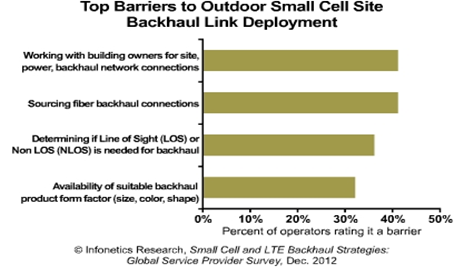Campbell, CALIFORNIA, 2013年1月16日-調査会社Infonetics ResearchはSmall Cell and LTE Backhaul Strategies: Global Service Provider Surveyより、その概要版を発表した。ここでは、屋外スモールセルおよびバックホールに関する事業者の現在、将来の計画を分析対象としている。

アナリストノート
「スモールセル採用オペレータにとっての課題は多い。屋外スモールセル向けに多くのテクノロジー、製品、トポロジーでテストとトライアルを実施してきたが、重大な局面に直面するにつれて、テクノロジーやオペレーションの担当者からだけではなくビジネスプラン策定者からのプレッシャーをますます受けるようになっている」と、Infonetics Researchの共同設立者でキャリアネットワークを担当している主席アナリストMichael Howardは述べている。
「しかしそれは容易なことではない。このオペレータは、さらに大きな課題にも直面している。屋外スモールセル機器はまだ小型・低価格ではないため、人口密度の高い都市部ではバックホールに問題がある。機器の外観、大きさ、色に関する地方自治体の規制のほか、街灯、電柱、建物外壁への機器設置主体に関する課題である。たとえこうした問題を解決できたとしても、財務上のテストをクリアしなくてはならないだろう。屋外スモールセル事業は、実行可能なビジネスモデルがないと成長は困難だろう」と、Howardは続けて述べている。
スモールセル・バックホールサーベイのハイライト
- 調査対象となったオペレータの86%は、様々な場所(建物、街灯、信号、電柱など)でマクロセルサイトの近くにスモールセルトラヒックをバックホールさせる計画がある。
- 調査対象事業者の間で最も好まれているテクノロジーは、利用可能性やコスト効率性の点で光ファイバである。しかし、直線有視界なし(NLOS)、スタンダードなマイクロ波、ミリ波など様々なマイクロ波が採用されるだろう。
- 所有コストに関して言えば、大多数の回答事業者は、スモールセル採用の5年TCO(総保有コスト)が典型的なマクロセルを採用した場合の10%以内でなくてはならないという。
- 2016年までに、屋内および屋外のスモールセル(マイクロセル、ピコセル、公共アクセスフェムトセル)はモバイルトラヒックの約4分の1に対応することになると調査対象事業者は予想している。
SURVEY SYNOPSIS
For its 36-page small cell and LTE backhaul survey, Infonetics interviewed purchase decision makers at 22 independent wireless, incumbent, competitive, and cable operators from EMEA, North America, and Asia Pacific about their current and future plans for small cell and macrocell backhaul. The study provides insights into mobile traffic handling and specific backhaul issues related to outdoor small cells, in-building small cells, and macrocells.
(原文)
Small cell operators face myriad operational and financial challenges
Campbell, CALIFORNIA, January 16, 2013-Market research firm Infonetics Research released excerpts from its Small Cell and LTE Backhaul Strategies: Global Service Provider Survey, which provides insights into operators' current and future plans for outdoor small cells and backhaul.
ANALYST NOTE
"The challenge is on for small cell operators. They've been scrambling to test and trial a large number of technologies, products, and topologies for outdoor small cells, and they're under growing pressure to make the rubber meet the road-not only from their technology and operations people, but even their business planners," notes Michael Howard, co-founder and principal analyst for carrier networks at Infonetics Research.
"But it won't be easy," continues Howard. "These operators face some daunting challenges: outdoor small cell gear isn't small enough or cheap enough yet, and there are problems backhauling in dense urban areas, not to mention municipal regulations regarding the look, size, and color of the equipment and who can mount equipment on streetlights, utility poles and building sides. Even if they managed to solve all these issues, they're still going to have to pass the fiscal test. Outdoor small cells won't fly without a viable business model."
SMALL CELL AND LTE BACKHAUL SURVEY HIGHLIGHTS
- 86% of operators surveyed plan to backhaul small cell traffic to nearby macrocell sites via a variety of locations, including buildings, streetlights, and traffic and utility poles
- Fiber is the preferred backhaul technology among respondent operators when available and cost effective, but the various forms of microwave-non-line-of-sight (NLOS), standard microwave, and millimeter wave-will be deployed most often
- When it comes to cost of ownership, a majority of respondents require the 5-year TCO of a small cell deployment to be within 10% of a typical macrocell deployment
- By 2016, those surveyed expect in-building and outdoor small cells (microcells, picocells, and public access femtocells) to handle around 1/4 of mobile traffic

